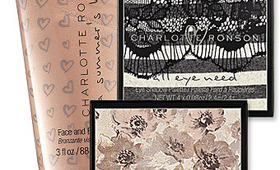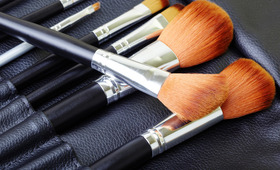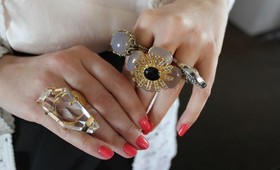How to Use Makeup Brushes with Liquids/Creams and Not Destroy Them
by Sonia G
Published Aug 31, 2023
Welcome to Sonia’s Fude Corner! Brush designer Sonia G. is here to share expertise and knowledge about her handcrafted Fude, plus tips, techniques, and advice to make the most out of your makeup brushes. Sign up here to get notified about Sonia’s newest articles.

Brushes are an investment. Unlike makeup, they don’t have an expiration date. But they do have a lifespan: when the brushes don’t work properly anymore, we should replace them. If we take care of them, they can last a very long time. So, what can we do to make them last as long as possible?
Using the right brushes with the right products will make a big difference. I’d like to answer one of your most frequently asked questions: How do you identify which natural brushes are safe to pair with cream and liquid formulations?
A full list of my Sonia G. brushes with my recommendations can be found at the bottom of this article.
Understanding How Brushes Get Damaged
The application of liquid products often requires a stronger (denser, firmer) brush to pick up and blend the product. When we apply pressure on the tip of a brush, either against a product or against the skin, some brushes can withstand the pressure better than others.
If the bristles are bending too much or if we have to aggressively rub them in order to get something done, then we need to switch brushes. Excessive pressure and aggressive movements are inevitably going to cause breakage.
All this means we need to take into consideration the hair quality, shape, firmness, and density of the brush. For a deeper dive on exactly how brushes get damaged, check out this article here.
Let’s Get Familiar With the Bristles
The most common natural bristles in the Fude market are goat bristles. Other common ones are horse and squirrel; sometimes you will also see weasel and kolinsky.
SQUIRREL
Squirrel bristles should only be used with powders. Some manufacturers may tell you differently but keep in mind that since these bristles are very fine and delicate, they are more likely to break when used with excessive pressure and will need to be replaced more frequently.
WEASEL OR KOLINSKY
If you have weasel or kolinsky brushes in your collection, these can be safely used with cream and liquid formulas.
HORSE
Horse bristles can technically be used with both powders and liquid/creams. Horse bristles are usually quite short and thick so they are resilient for any product formulation.
GOAT
Goat bristles can technically be used with both powder and liquid/creams, but it will also depend on the shape of the brush, the thickness of the bristles, if the bristles are dyed, and what type of dye was used.
And, not all natural goat and horse hair brushes are ideal to pair with liquids and creams because it could cause damage to the bristles, so let’s just dive into this a bit.
Identifying the Hair and Grades of Your Brushes
There are several types and grades of goat bristles. Some are super fine and delicate, others are sturdier and more durable. The finest, softest, and rarest is saibikoho (a selection of the finest saikoho bristles), then comes saikoho , then sokoho , then ototsuho , and hakutotsuho. There are more, but we don’t see them as often or sometimes the manufacturers name them different names.
The higher the grade, the finer and silkier the bristles are, but that means finer bristles like saikoho are also more delicate in comparison to sturdier bristles like ototsuho or hakutotsuho. In the Fude world, it’s common to see liquid foundation brushes made from ototsuho or hakutotsuho rather than saikoho. Even though they don’t feel as soft, they have more strength and more grip, which is better to deal with foundation and other creams and liquids.
There are times when white saikoho goat brushes can be used with creams and liquids, but it has to make sense. For example, a blush brush bundled with saikoho grade bristles might be just too weak and there is going to be too much friction, while a denser, shorter saikoho brush can be more resilient.
Can Dyed Bristles be Used for Creams and Liquids?
General Rules of Thumb:
-
Natural goat or horse hair brushes dyed with darker dyes could be used with creams and liquids if the manufacturer behind the brush recommends it.
-
Natural goat or horse hair brushes using white dyed bristles can be used with liquids and creams as they are unlikely to bleed dye, even with frequent washes. Just be sure to wash gently and take special care of them.
The Details:
You’ve probably heard that you shouldn’t use natural hair brushes with liquids and creams, but that’s not necessarily the case. The recommendation came from the common practice of dyeing natural bristles with black dye because frequent washing would sometimes cause the brush to bleed dye. Nowadays, many manufacturers are leaving hair natural. Methods and dyes differ depending on the artisans but it can be useful to know this additional information about the process:
When the dyeing process does occur, the artisans determine how much they want the bristles to be rinsed for optimal preservation of softness, strength, and durability. Their priority is to keep the structure of the natural bristle as strong as possible. This means that sometimes the brushes are not rinsed excessively and may bleed dye when we wash them ourselves at home. While it can be an alarming sight, it doesn’t mean the brush has or will have issues with liquids or creams. Still, it leads to brands not recommending dyed bristles, even when the dying process is done with very safe dyes.
The best way to have a clear answer is to call or email the brand or the manufacturer themselves and ask if they recommend their dyed brushes for creams and liquids. Their answers will vary based on a number of factors including the type of dye they used, the shape of the brush, or just their desire to preserve the condition of the brushes.
I, for one, love dyed bristles for many reasons, technical and aesthetic. For example, some of my brushes (from my own brand Sonia G.) are dyed with a brown color. The manufacturers behind my brushes said that although we can technically use these dyed brushes with creams and liquids, they don’t recommend it because it would be a shame to damage the fine and expensive saikoho goat bristles.
The Design of the Brush
When determining whether a brush can be used for creams and liquids, you must also consider the design of the brush head and the length of the bristles. You want to make sure that repeated application motions will be suitable for the brush and will not cause too much stress and pressure where the bristles may bend too much and break.
For example, a stronger natural bristle like hakutotsuho goat may only be suitable for creams and liquids if the length of the hairs is shorter. Longer bristles can bend too much and break when being used with creams and liquids.
Since saikoho is a common hair used in my brushes, here’s a quick guide:
Saikoho Brushes that Work with Creams and Liquids
- Shorter bristles and brushes with a denser / firmer construction
- Brushes that don’t require excessive pressure to be able to pick up product effectively
Saikoho Brushes that Don’t Work as Well with Creams and Liquids
- Brushes that have too much flexibility or airiness
- Good to keep in mind that it’s not ideal to use a pinched ferrule brush in strong circular movements
Below are some examples and brush recommendations.
Some Sonia G. Brush Recommendations for Liquids and Creams
For all over application:
The Lotus Base was designed for creams and liquids, it’s denser, firmer, and strong enough for the purpose. The Lotus Base has a mix of sokoho bristles and synthetic bristles. The synthetic bristles are going to help with the distribution of the product while the natural bristles help with the blending.
Mini Base is strong, and its round shape tends to be more appropriate for formulations when we want to blend using circular movements.
The Fusion eye brushes were designed to be used with creams and liquids because the mix of synthetic and goat bristles make them more resilient and ideal for cream formulations.
For buffing:
If you wish to buff creams and liquids, the Sheer Buffer , the Classic Base or the Mini Base were specially designed for this purpose. They are all bundled with a mix of sokoho goat and synthetic bristles.
For occasional use:
The Sky Classic Cheek is a saikoho goat brush that feels quite dense and sturdy. We may want to use it with creams and liquids, and it will work, but the brush has a pinched ferrule, the shape is not round, and we are going to be tempted to use it in circular motions to blend. This technique (circular movements instead of swipe movements) will put a lot of stress on the bristles. It’s ok for occasional gentle use with creams and liquids but not for regular use.
The Soft Shader is a saikoho goat eye brush, it works very well with powders and creams but it’s not a brush I would use regularly with creams due to the reasons explained in the How Brushes Get Damaged section.
Same for the Worker Two or Worker Three (these two brushes will be re-released in the Fundamental Eye series). They work great with creams and liquids, but because the bristles are really silky and fine, an intensive use with cream formulas is going to shorten their lifespan considerably.
Some Best Practices When Cleaning Your Brushes
What can we do to extend the durability of our natural brushes when we want to continue using them with creams and liquids?
- Make sure the brushes are dry before re-using them. Putting pressure on a brush that is not entirely dry could alter the stability of the glue area.
- Avoid the temptation of playing with the bristles or pulling on them when the brush is still drying, the glue area needs to be fully dry before we put any stress on it.
- Store them only when they are fully dry. Humidity is bad for the brushes so the faster they can dry the better. Don’t dry them in direct sunlight or with a hair dryer, just lay them flat to dry in a well-ventilated room.
- In between uses, wipe them on a gentle microfiber cloth to remove the excess product and bacteria.
- Brushes are bundled with a density and strength to cover a specific functionality. If we see that the bristles are bending too much, it’s better to grab a denser/firmer brush for the purpose.
Recommendations for Sonia G. Brushes
For my own brand, here is a table listing each brush as “ideal”, “occasionally”, “technically ok but not recommended” or “not recommended” for use with cream and liquid products.
| Brush | Brush Series | Ideal for Creams & Liquids | Ocassionally Ok to Use | Technically Ok, but Not Recommended | Not Recommended |
|---|---|---|---|---|---|
| Blender Pro | PRO | ✓ | |||
| Buffer Pro | PRO | ✓ | |||
| Builder Pro | PRO | ✓ | |||
| Cheek Pro | PRO | ✓ | |||
| Classic Base | Fusion | ✓ | |||
| Classic Cheek | SKY | ✓ | |||
| Classic Crease | SKY | ✓ | |||
| Crease Pro | PRO | ✓ | |||
| Designer Pro | PRO | ✓ | |||
| Detail Pro | PRO | ✓ | |||
| Face Pro | PRO | ✓ | |||
| Fan Pro | PRO | ✓ | |||
| Flat Definer | SKY | ✓ | |||
| Fundamental Classic Cheek | Fundamentals | ✓ | |||
| Fundamental Fan A | Fundamentals | ✓ | |||
| Fundamental Fan L | Fundamentals | ✓ | |||
| Fundamental Fan M | Fundamentals | ✓ | |||
| Fundamental Soft Buffer | Fundamentals | ✓ | |||
| Fundamental Worker L | Fundamentals | ✓ | |||
| Fusion Eye Blender | Fusion | ✓ | |||
| Fusion Eye Builder | Fusion | ✓ | |||
| Fusion Eye Detail | Fusion | ✓ | |||
| Fusion Eye Jumbo Worker | Fusion | ✓ | |||
| Fusion Eye Worker | Fusion | ✓ | |||
| Fusion Sheer Buffer | Fusion | ✓ | |||
| Hinoki Set | Hinoki | ✓ | |||
| Inochige Pro | PRO | ✓ | |||
| Jumbo Base | Fusion | ✓ | |||
| Jumbo Blender | SKY | ✓ | |||
| Jumbo Bronzer | SKY | ✓ | |||
| Jumbo Concealer | Fusion | ✓ | |||
| Lotus Base | Lotus | ✓ | |||
| Lotus Cheek | Lotus | ✓ | |||
| Master Face | SKY | ✓ | |||
| Mini Base | Fusion | ✓ | |||
| Mini Booster | SKY | ✓ | |||
| Mini Cheek | SKY | ✓ | |||
| Mini Keyaki Buffer | Mini Keyaki | ✓ | |||
| Mini Keyaki Crease | Mini Keyaki | ✓ | |||
| Mini Keyaki Detail | Mini Keyaki | ✓ | |||
| Mini Keyaki Jumbo Base | Mini Keyaki | ✓ | |||
| Mini Keyaki Jumbo Worker | Mini Keyaki | ✓ | |||
| Mini Keyaki NIJI | Mini Keyaki | ✓ | |||
| Mini Keyaki Soft Face | Mini Keyaki | ✓ | |||
| Niji Pro | PRO | ✓ | |||
| Pencil Pro | PRO | ✓ | |||
| Smooth Buffer | SKY | ✓ | |||
| Soft Cheek | SKY | ✓ | |||
| Soft Concealer | Fusion | ✓ | |||
| Soft Shader | SKY | ✓ | |||
| Worker Fan | SKY | ✓ | |||
| Worker Pro | PRO | ✓ |
You Might Also Like
-

Fashion
Fashion Inspired Makeup
- 27
-

Expert Skin Care Advice
What is Retinol?
- 320
-

Makeup
Fashion Designer and Makeup Collaborations
- 9
-

Makeup Brushes
Makeup Brushes: Q&A With Fiona Stiles
- 334
-

Hair
What Shampoo is Right For You?
- 266
-

Nails
Cocktail Ring and Manicure Combinations
- 67
-

Interviews
Are You Immune to Botox?
- 22
-

Wellness
Food Guilt: What's Normal?
- 85












Sep 1, 2023
Tracy L.
Great article, very well written! the table guide is very helpful to reference to ensure prevention of ruining the bristles.
Aug 31, 2023
Severine F.
Article riche, toujours intéressant et enrichissant à lire. Merci Sonia pour le travail fourni et toujours ce sens du détail et de la pédagogie. Cet article est très utile car nous avons des véritables trésors entre les mains et il est primordial d'en prendre soin , de les préserver. Merci énormément pour tout ce travail.